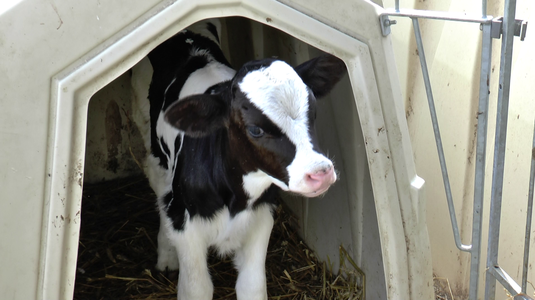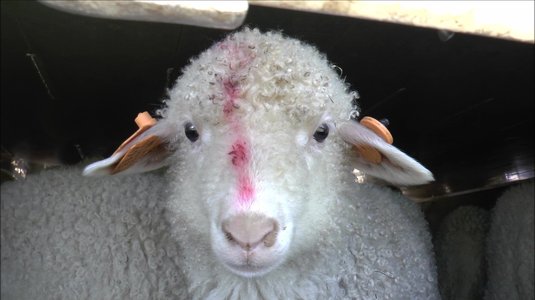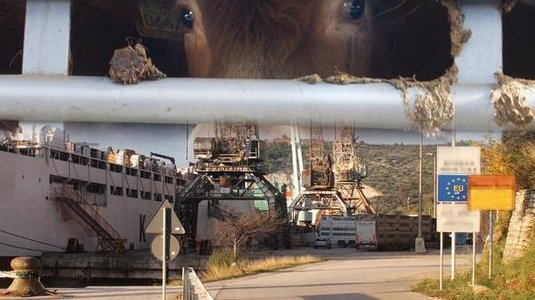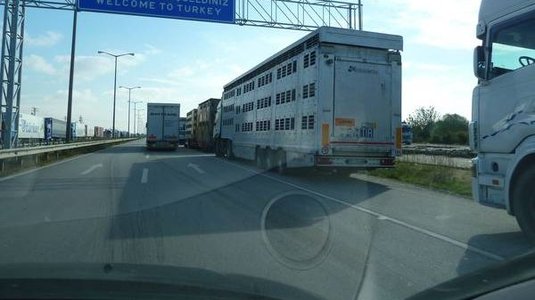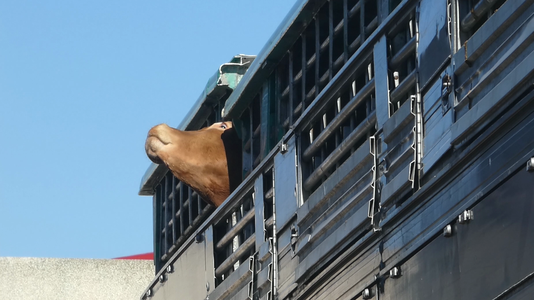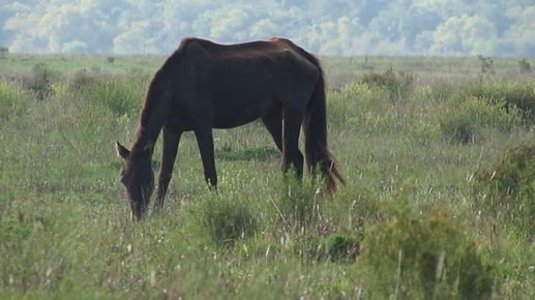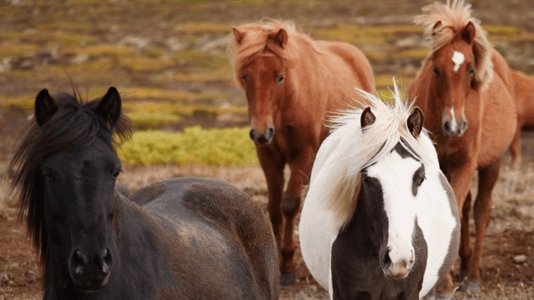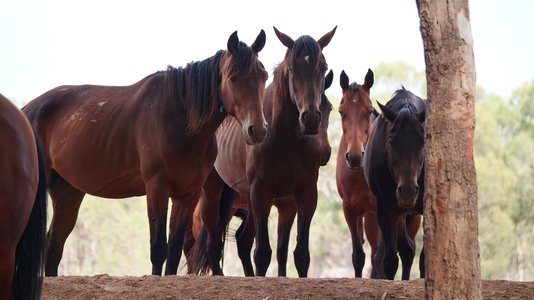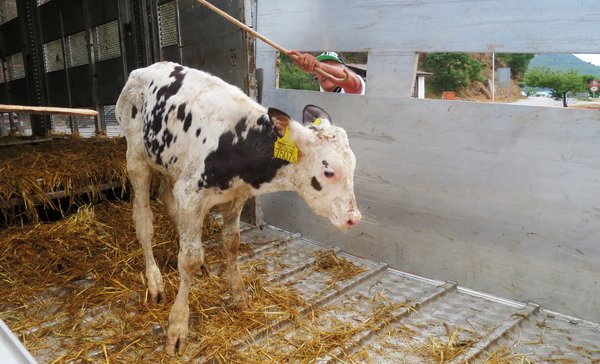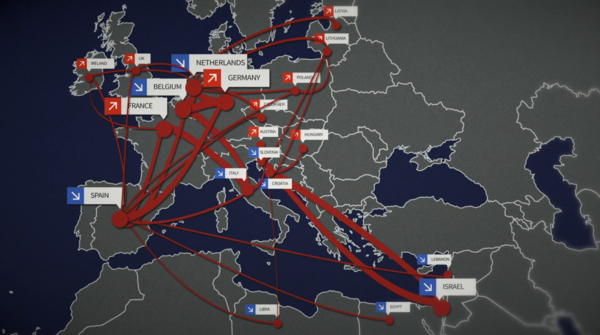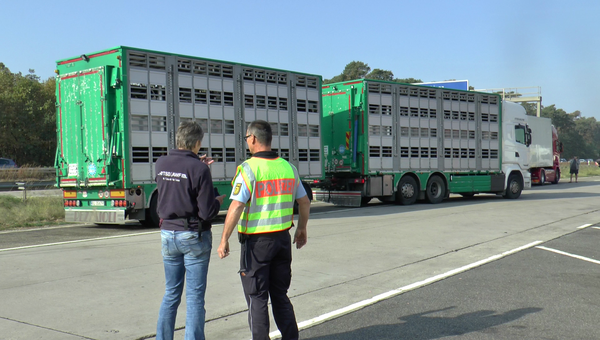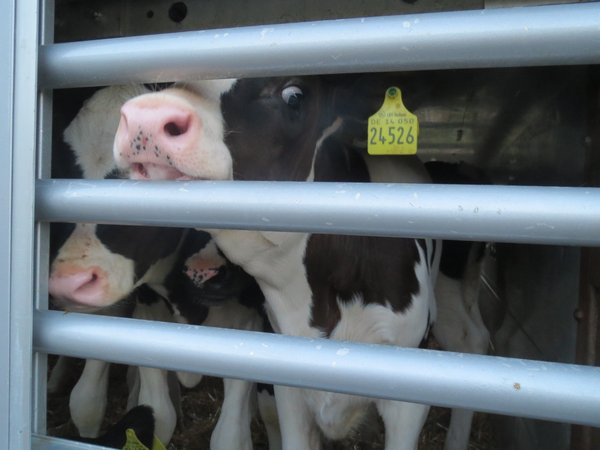Dossiers
Long-distance transport of unweaned calves
1. Introduction
This report focuses on long-distance transport of unweaned calves (animals that are still on a milk diet), which are transported by road over thousands of kilometres within the EU and even for several days by road and sea from EU to Third Countries.
Milk production is a very important activity in the EU. Production of milk is inseparably related to production of calves, very few of which re-enter the milk production cycle. The majority of calves are only by-products of milk production and are subject to one of three possibilities: to be killed soon after birth, to be reared for veal or to be reared for beef. The financial value of these calves is very low and varies between 8 and 150 Euros per calf, depending on country, breed and sex. To be reared for veal or beef, thousands of calves are transported on long journeys to farms in countries such as the Netherlands, Spain or Belgium from countries as far away as Lithuania, Poland and Ireland. In 2018, according to Eurostat database, 1.5 million calves under 80 kg were traded among the 28 EU Member States.
Furthermore, 750 thousand of unweaned calves were exported to Third countries by sea in the same year. During these long transports, the core element of Council Regulation (EC) No. 1/2005, Article 3, is systematically violated, because the animals cannot be provided with liquid feed in the vehicle. Consequently, unweaned calves regularly suffer from hunger and thirst during long-distance transport.
During investigations performed from 2014 to 2018, we documented 33 transports with unweaned calves. Our inspections resulted in more than hundred photos, many hours of video footage and in reports and complaints to the respective competent authorities. Our investigative teams documented serious breaches of the relevant legislation and the severe impact these breaches have on the transported animals. The provisions of Regulation (EC) No. 1/2005, Chapter V, point 1.3. and Chapter VI, point 2.2. of Annex I for long-distance transport of unweaned calves are regularly ignored. These fragile, young animals are still on a milk diet, with special demands regarding the quality of their food and the way it is offered to them. All of this cannot be provided in transport vehicles, and as a result the young animals are regularly suffering from feed/liquid deprivation.
The objective of this dossier is to show that the binding requirement of Council Regulation EC 1/2005 for the long-distance transport (transports of more than 8 hours) - the on-board supply of the animals with liquid/feed - cannot be put into practice in the case of unweaned animals.
2. Calves: By-products of the dairy industry
Milk is produced in every single EU Member State. The EU is a major player in the world dairy market as the leading exporter of many dairy products. The EU dairy sector is the second biggest agricultural sector in the EU, representing more than 12% of total agricultural output (2018, EPRS). For some Member States, dairy production forms a very important part of agricultural economy. Total milk production in the EU is estimated around 156 million tonnes per year (data from 2017). The EU's main milk producers are Germany, France, the United Kingdom, the Netherlands, Poland and Italy, which together account for almost 70% of the EU production (Eurostat, 2019). In 2018, 22.9 million cows were used for dairy in the EU-28. Germany had the largest dairy cow population: 4.22 million, followed by France with 3.63 million cows and Poland with 2.2 million animals (2019, M. Ridder).
In order to produce as much milk as possible, each cow gives birth to one calf each year, but the technical coefficient often used is 0.9, to take losses into account. That means that around 23 million calves are born in the EU each year. About 35% of the calves are reared to replace the slaughtered cows. Male calves and the remaining female calves are redundant and have a very low financial value. The calves are separated from their mothers almost immediately after birth. They are reared with milk or milk replacer, progressively supplemented by a cereal-based concentrate starter ration and forage (hay, silage or straw) as a source of fibre. The age at which calves are weaned from milk diet differs according to the region or country. Most calves are weaned between 4 to 8 weeks of age. Female, dairy-type calves (Holstein/Friesian) are reared to become replacement heifers for the dairy herd. Some dairy-type and half - bred calves are reared for beef in intensive systems. Others, of a more extreme dairy type may be destined for veal production or killed as unwanted shortly after birth and before registration (EFSA, 2012).
According to Regulation (EC) 1/2005 calves are considered to be unfit for transport under the age of 10 days. Thus, dairy farmers have to keep the calves for 10 days, before the animals can be collected by handlers and transported to assembly centres. Keeping and feeding calves on the farm is a loss for the dairy farmer, especially when the calf is sick or underweight and it can be assumed that farmers do not invest in such animals. They are the by-product of milk production and their financial value is between 8 and 150 euros per calf. The price varies depending on country and demand.
The low financial value of these animals is the reason why many of them will be transported over long distances to intensive veal farms in European countries specialised in fattening for beef (like Spain) or to countries specialised in veal market (like the Netherlands) (see map below). In 2018, 1.5 million calves under 80 kg of weight were traded between the 28 EU Member States. The main importers were The Netherlands (importing 728 thousand of calves); Spain (455 thousand); Belgium (133 thousand) and Poland (71 thousand). On the other hand, the main exporters were Germany (exporting 665 thousand); France (247 thousand); Ireland (115 thousand) (Eurostat,2019).
Furthermore, in the last 5 years (2014-2018), 23 thousand of calves weighing less than 80 kg were transported to third countries by ships, mainly to Israel, Lebanon and Egypt via the ports Slovenia, Spain and Croatia (Eurostat,2019). They are collected in the countries of origin on the milk-producing farms, for example in Lithuania, and transported by truck to the ports of southern Europe. There, they are loaded on livestock vessels and transported by sea for 5-7 days to the official destination countries, where they are loaded on trucks again. In April 2015, the European Court of Justice ruled that European animal welfare regulations should also be complied with when transporting animals outside EU borders. In practice, this is not controllable and animal welfare monitoring stops as soon as the animals enter the ship. No feedback on mortality rates is requested, so there are no official statistics on the number of animals that do not survive ship transport.
The term “unweaned” is used to describe calves that are still depending on a milk diet to survive, as physiologically they are not ready to independent intake of solid feed or water. These animals are transported over long distances within Europe, even though they have to be fed with a milk replacer, which is technically impossible in the trucks. As a result, the calves do not receive anything to drink (even if drinking system on the vehicle is filled with water, because - as explained above - they cannot digest water). Electrolyte solution does not meet nutritional requirements and cannot be considered part of feeding requirement.
Furthermore, calves of 2-5 weeks of age experience an immunological gap due to the shift between passive and active immunity and are unable to maintain constant body temperature by behavioural and physiological adaptation. As a consequence, unweaned animals suffer extremely during long-distance transport due to stress, feed/liquid deprivation and all the risk factors associated with long-distance transport (such as cold and heat stress).
Post-transport diarrhoea is not uncommon, 31% of unweaned Holstein calves present with diarrhoea within three weeks after transport (Morrison, 2019). Many of them cannot cope with transport and die before they reach their final destination. The economic indicators behind milk production mean that transport of millions of unweaned calves still continues. Thus, it is of utmost importance to consider the impact of long-distance transport on their welfare.
3. Findings from our investigations (2014-2018)
In the following chapter, the main problems documented by AWF|TSB in long-distance transports of calves within the EU are listed. In addition, the violated articles of the Regulation (EC) 1/2005 are added, as well as a brief description of the animal welfare problems and recommendations for improvements. The recommendations are based on the Regulation (EC) No 1/2005, as well as on scientific studies and letters of the European Commission. Several recommendations also refer to the “Guide to good practices for the Transport of young calves”, which has been published within the framework of a DG Sante project of the European Commission.
The summaries of each of 33 transports contain our observations and information gathered during the investigations from 2014 until 2018. The detailed reports of the investigations are available on request.
- Drinking devices inadequate for calves, restricted or no access to water
- Not enough feed stuff on board
- Inadequate bedding
- Insufficient space for the calves (floor area and headspace)
- Welfare conditions not inspected by drivers
- Transport of unfit/downer calves
- Transport of unweaned calves without special arrangements (road transport vehicles not equipped with watering system suitable for this category of animals.
- Inadequate vehicle design posing risk of injury
- Partitions posing risk of injury
- Faulty documentation
- Most of the transporters did not supplied the animals with liquid or feed after 9 hours of transport
- Many of transporters exceeded the maximum allowed journey times of 19 hours
- The planning of the journeys was unrealistic
According to the assessment of AWF|TSB, the problems observed in transports of unweaned calves within Europe are not incidental in nature, but regular, since the infringements were observed in every inspected road vehicle. In case of inspections with the police and official veterinary authorities, the infringements of the Regulation (EC) No 1/2005 were officially confirmed and fines for the breaches were imposed, also regarding violations of drivers’ social regulations.
One of the main concerns of AWF|TSB besides direct animal welfare problems is the fact that despite inspections performed by authorities and fines imposed by them, the same transporter companies were observed repeating the same violations of the Regulation (EC) No 1/2005 in the course of past few years, and no measures have been taken by these or other competent authorities to solve the problem efficiently. This means that the fines are neither effective, proportionate or dissuasive, even though this is required by Article 25 of the same Regulation.
AWF|TSB teams have been proving for numerous years now that it is impossible to transport unweaned calves for more than eight hours in conditions guaranteeing their welfare and with a strict enforcement of Council Regulation (EC) 1/2005.
4. Responsibilities
Besides the fines imposed by the police, AWF|TSB sent letters of complaint and information to the National Contact Points of the European countries involved in the trade of calves. In addition, the European Commission has been informed about the regular violations of the Regulation (EC) No 1/2005. However, until today, the conditions of transported calves remain poor and improvements of animal welfare are urgently needed.
The violations of the Regulation (EC) No 1/2005 occur at different levels and fall under the responsibility of different parties. The infringements are related to the planning of journeys and their approval, as well as the approval of inappropriate vehicles for the long-distance transport of calves. In addition, infringements are related to loading and transport conditions, i.e. the direct handling of the animals, for which keepers, transporters and attendant/drivers are responsible. Furthermore, transporters and transport organisers are responsible for the welfare of the transported calves during the whole journey.
The main responsibility regarding the transport lies in the hands of the transport organiser and the transporter. However, documentation of AWF|TSB shows that in many cases economic considerations seem to play a larger role than the welfare of animals from which the transporters profit.
The fact that neither police fines, nor official complaints have led to any major improvements, shows that there is a general problem of enforcement of the Regulation (EC) No 1/2005 and that Article 25 (Penalties) is not being complied with. The problems in this regard start with the fact that the authorities at the place of destination frequently fail to notify the competent authorities at the place of departure about infringements found, this way failing to implement measures to remedy the breaches or prevent the recurrence of infringements according to Article 26 (Infringements and notification of infringements).
The lack of notifications between the member state of destination and the member state of departure contributes clearly to lack of enforcement of the Regulation.
5. Conclusion
This dossier illustrates that long-distance transport of unweaned calves is not practicable without exposing these animals to conditions that are causing unnecessary suffering to them, due to the deprivation from food over a long period of time and subsequent welfare problems. This often results in weakness or even in the death of animals.
When it comes to long-distance transport of unweaned calves, the core element of the Regulation, which is Article 3, is notoriously disregarded. In accordance with Article 3, “No person shall transport animals or cause animals to be transported in a way likely to cause injury or undue suffering to them.” Moreover, our observations indicate that Council Regulation (EC) 1/2005 is systematically undermined in regards of long-distance transport of unweaned calves.
The major reason for the poor enforcement is the contradiction in the Regulation itself that tolerates long-distance transport of unweaned calves, even though the binding requirements cannot be put into practise.
These animals are still on a milk diet, with special demands for the quality of their food and the way it is offered to them, none of which can be fulfilled in transport vehicles. Currently, not a single producer managed to produce a drinking system suitable for the supply of warm electrolyte solution or milk replacer on the transport vehicle. Hence, type 2 transporter authorisations should not be granted for long-distance transport of unweaned calves.
As the transport of unweaned animals is problematic with regard to meeting their feeding and watering needs, we ask the Commission of the European Union and the Member States for the following:
- The term “unweaned” needs to be defined for all species in the Regulation (EC) 1/2005. According to the SANCO recommendations (2008), calves under the age of two months could be considered as unweaned.
- The exceptions from the maximum transport time of eight hours should be revised in the Regulation (EC) No 1/2005. Unweaned calves should not travel more than eight hours.
- Calves under the age of 14 days should not be transported at all and should be considered as unfit for transport.
- Unweaned calves cannot be supplied adequately inside a vehicle and should therefore, after nine hours of transport, be unloaded, fed and rested for 24 hours at a control post.
- Electrolyte solution at assembly stations, control posts or at destination, should only be offered once in order to prevent diarrhoea. Electrolyte solution does not satisfy the hunger, milk replacer should be used instead.
- Transport of unweaned calves should only be approved if the outside temperatures are above 0°C.
- Type 2 transporter authorisations covering calves should only be granted for the weaned ones, and only when the design and the position of drinking devices allows the animals to make use of them.
- Type 2 transporter authorisations should not be granted for the transport of any unweaned animals.
- Type 2 transporter authorisations should be granted for the transport of young animals, only when the design of the vehicle does not cause a risk for injuries (e.g. trapped legs).
- In order to assess the correctness of the information provided by the transporters about planned journey times, an average speed of 60 km/h should be assumed. This will lead to more realistic transport times.
- Authorities need to take the enforcement of the Regulation (EC) No 1/2005, as well as the protection of animals during transport – the actual goal of the Regulation – seriously.
- More inspectors specialised in animal transport are needed, while fines imposed should be related to the additional profit gained by breaking the law and should constitute a noticeable loss for the organisers and transport companies.
In the resolution of February 14, 2019 on the implementation of Council Regulation (EC) No 1/2005 on the protection of animals during transport, the European Parliament calls on the European Commission to shift from transporting live animals to the transport of meat and carcasses (point 53) and calls on the member states to not transport unweaned animals for more than eight hours in total (point 44).
AWF|TSB rejects long-distance transports of unweaned calves (transports of more than 8 hours).
We demand that unweaned calves may only be transported over short distances within the EU.
[1] With this resolution, in point 53, the European Parliament “Calls on the Commission to develop a strategy to ensure a shift from live animal transport to a mainly meat-and-carcass and germinal products trade, given the environmental and animal welfare and health impacts of live animal transport; [….]” Source).
The full dossier on the long distance transport of calves consists of 44 pages.
On request, the full dossier can be made available to competent authorities, veterinarians and media representatives.
